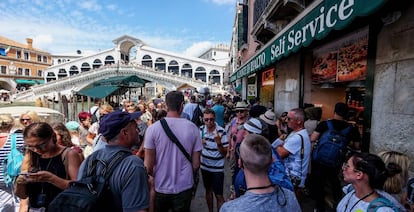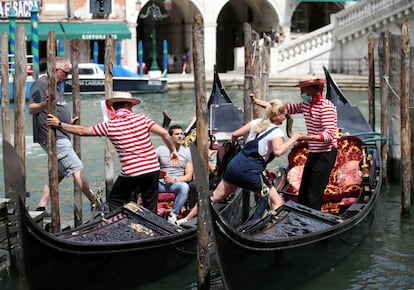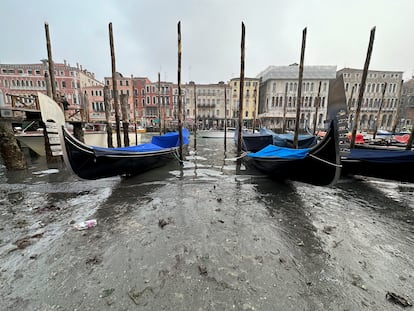Venice will charge tourists who don’t spend the night in the city a €5 entry fee
The measure is announced as the UNESCO debates adding the site to its endangered world heritage blacklist

Venice continues struggling to combat the massive tourism that is putting the city and its residents’ life at risk, as UNESCO has repeatedly warned. Venetian authorities have now approved a €5 entry fee to those who come to spend the day. The system will be implemented next summer in the city that now receives around 30 million tourists a year.
The Venetian consistory proposes introducing an entry fee for all tourists who visit the historic center during the day, without spending the night. The local administration plans to implement a trial period of 30 non-consecutive days over spring and summer weekends in 2024.
In the coming weeks, the local administration will approve the details of the project. In a statement, they specified that the ticket will be available for purchase on a multilingual platform, which will be available in the coming months.
Exceptions
Not all day visitors will have to pay. Exceptions include residents of the municipality of Venice, those who are coming for work or school, children below 14 years old, those who need medical treatment, participants in sporting events and families of residents up to the third degree.
The administration’s intention is to “disincentivize day tourism in certain periods, given the city’s delicacy and singularity.” The Consistory will not benefit from the introduction of the fee, as, according to tourism minister Simone Venturini, the income will only function to cover the costs of the system. The intention is to “guarantee residents a better quality of life,” as well as improving the experience of tourists who spend at least one night in the city. “The message we want to communicate is that Venice is accessible, open, but visitors, both local and foreign, should understand that there needs to be scheduling to better manage the balance between residence and tourism,” councilman Michele Zuin explained.

Venice has long had trouble managing the heightened flow of tourists. Many visitors do not stay in the city, but go only for a single day and move quickly through the main sites in the historic center, using public services like transportation and bathrooms. Day visitors do not pay the tourist fee that is obligatory for those who spend the night. The arrival of large groups of tourists causes problems for residents. Tourism has also contributed to increasing the price of services and real estate, as property owners prefer to rent apartments to tourists over long-term contracts.
The administration announced the project a few days before UNESCO began to examine Venice’s inclusion on its blacklist of endangered world heritage sites. The UNESCO World Heritage Committee will discuss it in a meeting in Riadh, Saudi Arabia, starting September 10.
Risk of ‘irreversible damage’
In June, the organism warned that climate change, reform projects and mass tourism is putting the city at risk of suffering “irreversible” damage. And it denounced that these “ancient, but urgent” problems with Venice and its lagoon will not be solved by the inefficiency of local and national authorities and their lack of coordination. It also noted that “insufficient” measures have been taken to improve the situation and lamented “the absence of a common global strategic version.”
It is not the first time that Venice has introduced an entry fee to decrease the flow of tourists that pass through the city. Two years ago, the Consistory approved a similar measure, with an entry fee of between €3 and €10, which should have gone into effect this year. But the fee’s implementation has been postponed. Putting it into practice has been more complicated than expected, due to technical, legal and political obstacles. Last year, authorities warned of the risk of “massive personal data gathering,” which could spread detailed information about people’s habits, movements, behavior or health.
Practical difficulties have also come up, such as the need to create a global information campaign for tourists about the new norms, reach agreements with hotels, platforms and transportation companies and implement systems for payment, entry authorization and sanctions.
The opposition has criticized the new proposal by mayor Luigi Brugnaro, whose government is supported by a right-wing coalition. For some politicians, the fee is too low to be effective. “The idea that charging €5 a few days a year can save the city from mass tourism is emblematic of a city government that has no ideas,” Monica Sambo, from the Democratic Party, told the Corriere del Veneto. The center-left organization Tutta la Città Insieme has called the measure a “mess”, saying, “Venice is not a museum that is entered by paying a fee.”
Sign up for our weekly newsletter to get more English-language news coverage from EL PAÍS USA Edition
Tu suscripción se está usando en otro dispositivo
¿Quieres añadir otro usuario a tu suscripción?
Si continúas leyendo en este dispositivo, no se podrá leer en el otro.
FlechaTu suscripción se está usando en otro dispositivo y solo puedes acceder a EL PAÍS desde un dispositivo a la vez.
Si quieres compartir tu cuenta, cambia tu suscripción a la modalidad Premium, así podrás añadir otro usuario. Cada uno accederá con su propia cuenta de email, lo que os permitirá personalizar vuestra experiencia en EL PAÍS.
¿Tienes una suscripción de empresa? Accede aquí para contratar más cuentas.
En el caso de no saber quién está usando tu cuenta, te recomendamos cambiar tu contraseña aquí.
Si decides continuar compartiendo tu cuenta, este mensaje se mostrará en tu dispositivo y en el de la otra persona que está usando tu cuenta de forma indefinida, afectando a tu experiencia de lectura. Puedes consultar aquí los términos y condiciones de la suscripción digital.
More information
Últimas noticias
Rowan Atkinson tops Netflix at 70: ‘He’s as funny as ever’
Israeli recognition of Somaliland stirs up the Gulf
Tiger Woods turns 50: Will he continue playing on the PGA Tour or take a back seat?
The surreal journey of James Nnaji, the Barcelona youth player selected in the NBA Draft who ended up in the NCAA
Most viewed
- Oona Chaplin: ‘I told James Cameron that I was living in a treehouse and starting a permaculture project with a friend’
- Reinhard Genzel, Nobel laureate in physics: ‘One-minute videos will never give you the truth’
- Sinaloa Cartel war is taking its toll on Los Chapitos
- Why the price of coffee has skyrocketed: from Brazilian plantations to specialty coffee houses
- Chevy Chase, the beloved comedian who was a monster off camera: ‘Not everyone hated him, just the people who’ve worked with him’










































